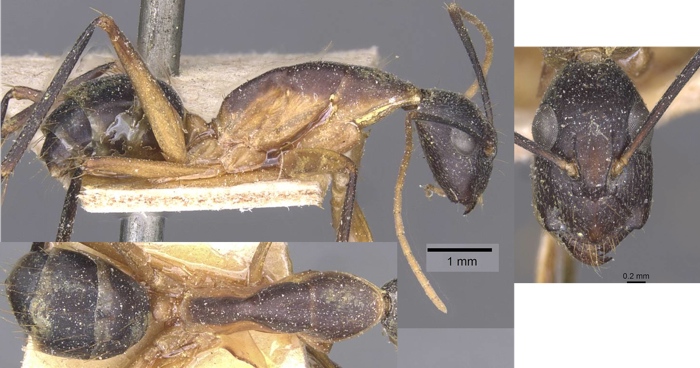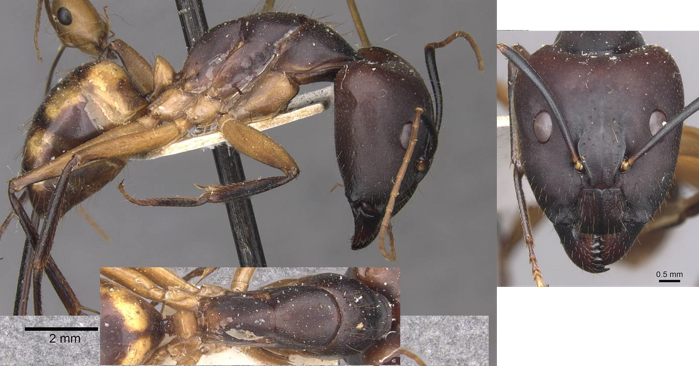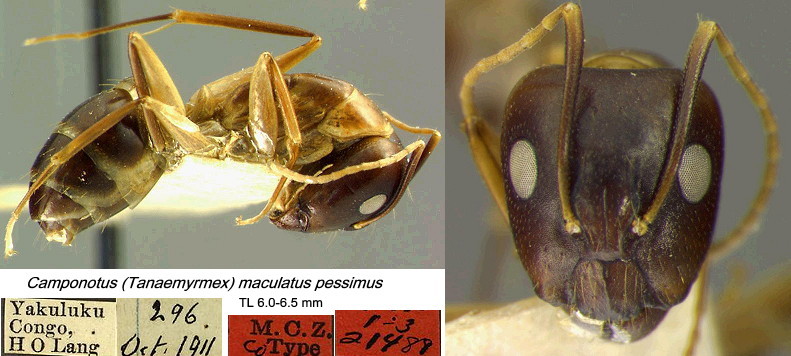Genus Camponotus subgenus Tanaemyrmex
Camponotus maculatus nominal varieties - forms separated as not being "maculatus" group species
| The
Ants of Africa Genus Camponotus subgenus Tanaemyrmex Camponotus maculatus nominal varieties - forms separated as not being "maculatus" group species |
|
| Camponotus maculatus introduction |
| lacteipennis (Formica lacteipennis, Smith F., 1858b: 34, all forms) |  Smith's
(1858b) description is at Smith's
(1858b) description is at Collected from http://www.antweb.org/specimenImages.do?code=casent0903512 |
South Africa |
| nubis (Camponotus (Myrmoturba) maculatus (Fabr.) nubis, subsp. nov., Weber, 1943c: 385, illustrated, Major & Minor) |
No images on Antweb (October 2014). |
South Sudan |
| . |
|
. |
| ugandensis |
 |
|
| sudanicus (Camponotus (Myrmoturba) maculatus (Fabr.), sudanicus subsp. nov., Weber, 1943c: 385, Major & Minor; synonymy by Baroni Urbani 1972: 125) |  Collated
illustration
(right) is of a cotype of Camponotus maculatus
ssp sudanicus (Weber, 1943c: 385, major & minor workers;
synonymy by Baroni Urbani 1972: 125) from South Sudan.
The original photographs, together with enlarged images, are from the
MCZ, Harvard University, website at - MCZ link. Weber's
(1943c) description of sudanicus is at Collated
illustration
(right) is of a cotype of Camponotus maculatus
ssp sudanicus (Weber, 1943c: 385, major & minor workers;
synonymy by Baroni Urbani 1972: 125) from South Sudan.
The original photographs, together with enlarged images, are from the
MCZ, Harvard University, website at - MCZ link. Weber's
(1943c) description of sudanicus is at Minor tL 6.4 mm. This does not seem to be any different to nubis see above. However, nubis was found nesting in the black montane humus under stones and among grass roots, whereas the single nest of sudanicus was in the stub of a tree branch. Despite describing both, Weber makes no reciprocal comparisons. The small size suggests this is a distinct species. |
Sudan |
| Camponotus liengmei (Camponotus sexpunctatus n. spec. var. liengmei, Forel, 1894b: 67, Major & Minor; Forel, 1907g: 88, male) |  Forel's (1894b)
description
is at Forel's (1894b)
description
is at As with Camponotus sexpunctatus, this is a large form, major TL 15-17.3 mm; head elongate trapezoidal, distinctly longer than wide (liengmei shape); tibiae prismatic with setae present (piquants). The photomontage is of a cotype of Camponotus maculatus ssp liengmei. The original photographs, together with enlarged images, are from the MCZ, Harvard University, website at - MCZ link. Given various statuses, this was placed as a subspecies/race of maculatus by Forel (1901h: 69), it was raised to species by Santschi (1923e: 292), then reduced to a junior synonym of maculatus by Baroni Urbani (1972: 125). The distinctive images of the cotype and a fresh specimen from Kenya, persuade me that it merits full species status. |
Mozambique |
| minor worker |  |
. |
| hansingi (Camponotus maculatus F. subsp. Liengmei Forel v. Hansingi, n. var., Forel, 1910e: 452, Major) | Forel's (1910e) description
is at No images on Antweb (October 2014) |
Mozambique (also South Africa) |
| importunoides (Camponotus (Myrmoturba) maculatus F. r. Liengmei Forel v. importunoides, n. var., Forel, 1914d: 249, Major & Minor) | Forel's (1914d) description
is at No images on Antweb (October 2014) |
South Africa |
| cognatomaculatus (Camponotus rubripes r cognatus var cognatomaculatus, Forel, 1886f: 151, worker; given as Forel, 1889: 255, unavailable name in Bolton 1995: 93) | Forel's (1886f) mention of
the name but without any obvious description (two specimens before him)
is at |
Kakoma - Equatorial Africa (there are several possibilities; the name Kakoma appears twice in Congo DR, possibly the most likely candidate |
| madecassa (Camponotus maculatus subsp. liocnemis var madecassa n.var., Emery, 1905d: 30, footnote, worker) | Emery's (1905d) description
is at |
Madagascar |
| pessimus (Camponotus maculatus subspecies miserabilis Santschi variety pessimus, new variety, Wheeler, 1922: 235, Major & Minor) |
Wheeler (1922) had - Major TL only 6-6.5 mm, Minor TL 5-5.5 mm, as miserabilis but much smaller; "the head of the major is distinctly narrower anteriorly, the cheeks being less convex and the frontal carinae are less approximated. Sculpture, pilosity and color very much as in miserabilis" - it seems possible that this is synonymous with Camponotus (Tanaemyrmex) agonius but that is inadequately described; image collated from http://mcz-28168.oeb.harvard.edu/mcz/FMPro?-DB=Image.fm&-Lay=web&-Format=images.htm&Species_ID=21488&-Find |
Zaïre |
 |
| Camponotus maculatus main entry |
© 2010, 2013, 2014
- Brian Taylor CBiol FSB FRES 11, Grazingfield, Wilford, Nottingham, NG11 7FN, U.K. |
href="camponotus_maculatus_separated_forms.htm"